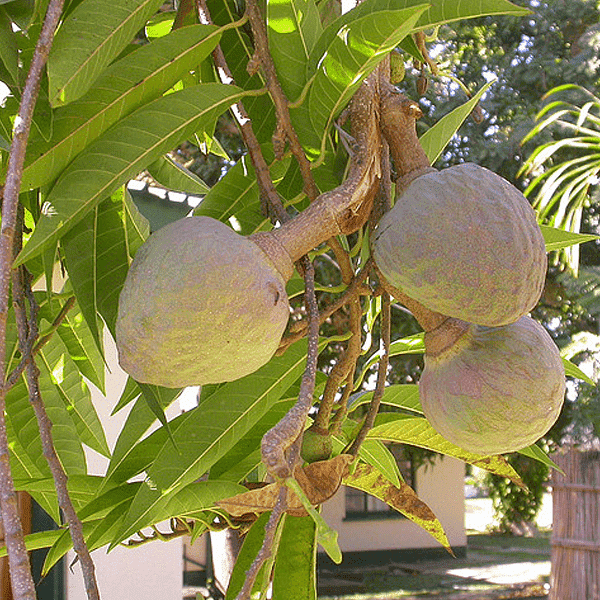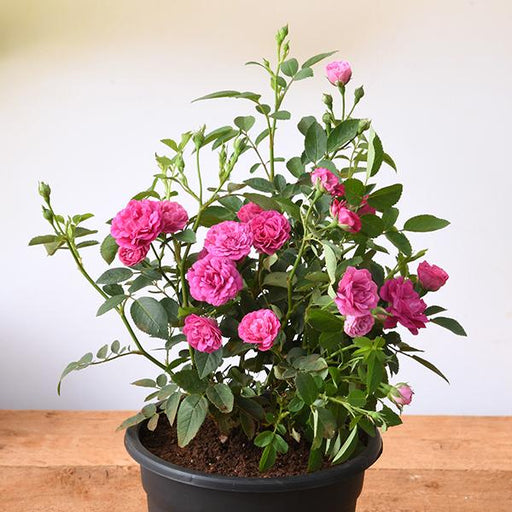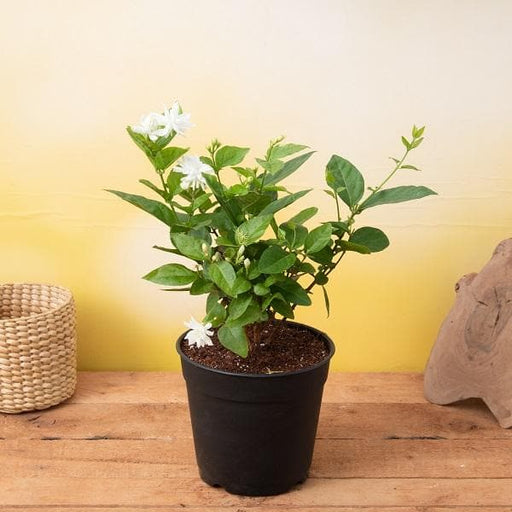
Ramphal, Annona reticulata (Grown Through Seeds) - Plant
(MRP Inclusive of all taxes)
- Shipping ₹79 for entire order
- Dispatch in 7 days
- Country of origin: India

(MRP Inclusive of all taxes)
 Save 29%
Save 29%
Air Purifier Money Plant with Pot The Air Purifier Money Plant, also known as Pothos or Epipremnum aureum, is a stunning indoor plant that...
View full details
 Save up to 15%
Save up to 15%
Peace Lily, Spathiphyllum - Plant The Peace Lily, scientifically known as Spathiphyllum, is a stunning houseplant celebrated for its elegant white...
View full details
 Save 25%
Save 25%
Jasminum sambac, Mogra, Arabian Jasmine - Plant Jasminum sambac, commonly known as Mogra or Arabian Jasmine, is a fragrant flowering plant...
View full details
 Save 18%
Save 18%
Combo Constituents Includes the Parijat Tree (Night-Flowering Jasmine), a culturally significant plant with fragrant flowers. Description The Pari...
View full details
 Save 25%
Save 25%
Miniature Rose, Button Rose (Any Color) - Plant The Miniature Rose, also known as the Button Rose, is a charming and compact flowering plant that ...
View full details Save 25%
Save 25%
Damascus Rose, Scented Rose (Any Color) - Plant The Damascus Rose, also known as Rosa damascena, is a timeless symbol of beauty and romanc...
View full details
 Save 17%
Save 17%
Beautiful Fragrant Mogra, Arabian Jasmine Plant with Pot The Beautiful Fragrant Mogra, also known as Arabian Jasmine (Jasminum sambac), is...
View full details Save 15%
Save 15%
Pack of Vermicompost and Neem Cake for House Plants Transform your indoor garden with our premium Pack of Vermicompost and Neem Cake, spec...
View full details
Pack of Plant Growth and Flower Boosters Unlock the full potential of your garden with our Pack of Plant Growth and Flower Boosters! This ...
View full details Save 38%
Save 38%
Combo of Jeevamrut and Neem Raksha for Easy Growth and Protection of Houseplants Transform your indoor garden with our exclusive combo of ...
View full details Save 22%
Save 22%
Plant Nutrients Kit (Pack of 16) for a Healthy Garden Transform your garden into a lush paradise with our Plant Nutrients Kit, featuring 1...
View full details Save 16%
Save 16%
Combo of Top Plant Fertilizers Elevate your gardening game with our exclusive Combo of Top Plant Fertilizers, featuring two bags of premiu...
View full details Save 24%
Save 24%
Pack of 4 Additives to Make Soil Healthy and Nutrient Rich Transform your garden into a thriving ecosystem with our Pack of 4 Additives de...
View full details Save 30%
Save 30%
Transform your gardening experience with our premium Combo of Perlite and Vermiculite. This unique blend is designed to enhance soil aeration and ...
View full details Save 27%
Save 27%
Combo of 2 Vermicompost and Cocopeat - Enrich Your Soil Naturally! Transform your garden into a thriving ecosystem with our Combo of 2 Ver...
View full details
 Save 35%
Save 35%
Best 6 Plants for Perfect Indoor Garden Transform your living space into a lush oasis with our curated collection of the Best 6 Plants for a...
View full details
 Save up to 50%
Save up to 50%
Mini Succulent Garden Pack Transform your space with our Mini Succulent Garden Pack, featuring a delightful collection of 4 any variety beautiful s...
View full details
 Save 30%
Save 30%
5 Best Fragrant Plants Transform your garden or indoor space into a fragrant paradise with our curated selection of the 5 Best Fragrant Plants. Th...
View full details
 Save 24%
Save 24%
Set of 2 Bonsai Looking Grafted Adeniums Transform your indoor or outdoor space with our exquisite Set of 2 Bonsai Looking Grafted Adenium...
View full details Save 45%
Save 45%
Top 4 Die Hard Succulents Pack Transform your indoor or outdoor space with our Top 4 Die Hard Succulents Pack, featuring a curated selecti...
View full details
 Save 30%
Save 30%
5 Best Indoor Plants Pack Transform your living space into a lush oasis with our '5 Best Indoor Plants Pack.' This carefully curated collection fe...
View full details
 Save 25%
Save 25%
Set of 4 Evergreen Air Purifier Plant Pack Transform your indoor space into a lush, green oasis with our Set of 4 Evergreen Air Purifier Pla...
View full details| SrNo | Item Name | Qty |
|---|---|---|
| 2 | Ramphal (Grown Through Seeds) Plant | 1 |
The Ramphal, or Annona reticulata, is a tropical fruit tree known for its unique, sweet, and creamy fruit. This plant is not only a delight for the palate but also a beautiful addition to any garden. With its heart-shaped leaves and fragrant flowers, the Ramphal tree can grow up to 10 meters tall, making it a stunning focal point in your landscape.
What makes the Ramphal special is its rich nutritional profile, packed with vitamins A and C, fiber, and antioxidants. This tree is also known for its resilience in various soil types, making it an excellent choice for sustainable gardening. Its fruit is often used in desserts, smoothies, and traditional medicines, showcasing its versatility.
One of the standout features of the Ramphal is its ability to thrive in warm climates, making it an ideal choice for tropical and subtropical regions. The tree's unique fruit, often referred to as the "custard apple," has a creamy texture and a flavor reminiscent of banana and mango, making it a favorite among fruit enthusiasts.
Growing Ramphal contributes positively to the environment by enhancing biodiversity and providing habitat for various species. Its deep roots help prevent soil erosion, and the tree's ability to thrive in poor soils makes it a sustainable choice for reforestation efforts.
If you think growing Ramphal is as easy as pie, think again! This tropical delight, also known as Annona reticulata, requires a bit of finesse. Start with well-draining soil and a sunny spot, and remember, patience is a virtue. Water it like you’re nurturing a diva—just enough to keep it happy, but not so much that it feels like it’s drowning. With a little love and care, you’ll be rewarded with a fruit that’s sweeter than your favorite dessert!
Ah, the mystery of seed germination! It’s like waiting for a surprise party where the guest of honor is a Ramphal tree. Soak those seeds overnight to wake them up from their slumber, then plant them in warm, moist soil. Keep them cozy and watch as they sprout, like magic! Just remember, not all seeds are created equal; some may take their sweet time, so don’t lose hope if they’re fashionably late.
a tropical paradise where the sun shines bright and the soil is rich. That’s the ideal growing condition for your Ramphal! This plant loves warmth and humidity, so if you live in a cooler climate, consider giving it a cozy indoor spot. Ensure it gets plenty of sunlight, but don’t let it roast like a marshmallow. A little shade during the hottest hours can go a long way in keeping your plant happy and thriving.
Every plant has its nemeses, and for Ramphal, it’s the pesky pests! Aphids, mealybugs, and fruit flies can turn your gardening dream into a nightmare. But fear not! A little neem oil or insecticidal soap can be your superhero. Regularly inspect your plant and give those pests the boot before they throw a wild party on your precious Ramphal. Remember, a vigilant gardener is a happy gardener!
Just like us, Ramphal trees need their vitamins and minerals to grow strong and healthy. A balanced fertilizer, rich in nitrogen, phosphorus, and potassium, will do wonders. Think of it as a spa day for your plant! Feed it every few months during the growing season, and watch it flourish. But don’t overdo it; too much fertilizer can be like too much caffeine—jittery and unhealthy!
Pruning your Ramphal is like giving it a stylish haircut. It helps shape the tree and encourages healthy growth. Use sharp, clean tools to snip away dead or overcrowded branches, allowing sunlight to reach the inner foliage. Don’t be afraid to get a little creative; a well-pruned tree can be a work of art! Just remember, less is more—over-pruning can leave your plant feeling exposed and vulnerable.
The moment you’ve been waiting for—harvesting your Ramphal! But hold your horses; timing is everything. Wait until the fruit turns a lovely yellow-brown and gives a little when you press it. If you pick it too early, you’ll be left with a mouthful of disappointment. Once harvested, let it ripen for a few days at room temperature, and then enjoy the sweet, creamy goodness that will make your taste buds dance!
Who knew that your Ramphal tree could double as a gourmet chef? The creamy, custard-like flesh of the fruit is perfect for smoothies, desserts, or just eating straight off the skin. Blend it into a tropical shake or whip up a fancy sorbet that will impress your friends. The possibilities are endless, and your taste buds will thank you for the culinary adventure!
Move over, kale! Ramphal is here to steal the spotlight with its health benefits. Packed with vitamins, antioxidants, and fiber, this fruit is a nutritional powerhouse. It can aid digestion, boost immunity, and even promote healthy skin. So, indulge in this tropical treat guilt-free, knowing you’re doing your body a favor. Who knew that something so delicious could also be so good for you?
Want to spread the Ramphal love? Propagation is the way to go! While growing from seeds is the most common method, you can also try grafting or air layering for quicker results. Just remember, patience is key—good things come to those who wait. With a little effort, you’ll have a mini Ramphal forest in no time, and your friends will be begging for a slice of the action!
Planting a Ramphal tree isn’t just a treat for your taste buds; it’s a gift to Mother Earth! These trees help improve air quality, provide shade, and support local wildlife. Plus, they’re a great way to combat climate change, one delicious fruit at a time. So, while you’re enjoying your Ramphal, take a moment to appreciate the positive impact you’re making on the environment. It’s a win-win situation!
Ramphal, also known as Annona reticulata, is a tropical fruit tree that produces a sweet, custard-like fruit. It’s like nature’s dessert, just waiting to be plucked! This delightful plant is perfect for those who want to add a touch of exotic flair to their garden.
Growing Ramphal from seeds is like playing a game of patience. Soak the seeds overnight, plant them in well-draining soil, and keep them warm and moist. In a few weeks, you’ll have tiny green warriors ready to take on the world—or at least your backyard!
Ramphal loves a warm hug! It thrives in tropical and subtropical climates with plenty of sunlight and well-drained soil. Think of it as a sunbather that enjoys a good drink of water but hates soggy feet.
Patience is a virtue, my friend! Ramphal seeds typically take about 2 to 4 weeks to germinate. Just remember, good things come to those who wait—like delicious fruits that will make your taste buds dance!
Your Ramphal tree will start bearing fruit in about 3 to 5 years. It’s like waiting for a fine wine to age—worth every moment! Soon, you’ll be the proud owner of a tree that produces sweet, creamy fruits.
Water your Ramphal plant regularly, but don’t drown it! Aim for a balance—keep the soil moist but not soggy. Think of it as giving your plant a refreshing drink without turning it into a swimming pool.
Keep an eye out for pesky pests like aphids and fruit flies. They can be as annoying as a fly at a picnic! Regularly inspect your plant and use organic pest control methods to keep these uninvited guests at bay.
Absolutely! Ramphal can be grown in a pot, making it the perfect candidate for container gardening. Just ensure the pot is large enough for its roots to stretch out and enjoy the good life.
Yes, indeed! Ramphal fruit is not just edible; it’s a tropical delight! With its creamy texture and sweet flavor, it’s like a party in your mouth. Just scoop out the flesh and enjoy the deliciousness!
Ripe Ramphal fruit will feel slightly soft to the touch and have a sweet aroma. It’s like a gentle nudge from nature saying, “Hey, I’m ready to be devoured!” Harvest it when it’s just right for the ultimate taste experience.
Ramphal fruit is a nutritional powerhouse! Packed with vitamins, antioxidants, and fiber, it’s great for digestion and boosts your immune system. Eating it is like giving your body a high-five while indulging in a sweet treat!
Ramphal trees are not fans of the cold! They thrive in warm climates and can suffer in temperatures below 50°F. If you live in a chilly area, consider growing it indoors or in a greenhouse to keep it cozy and happy.